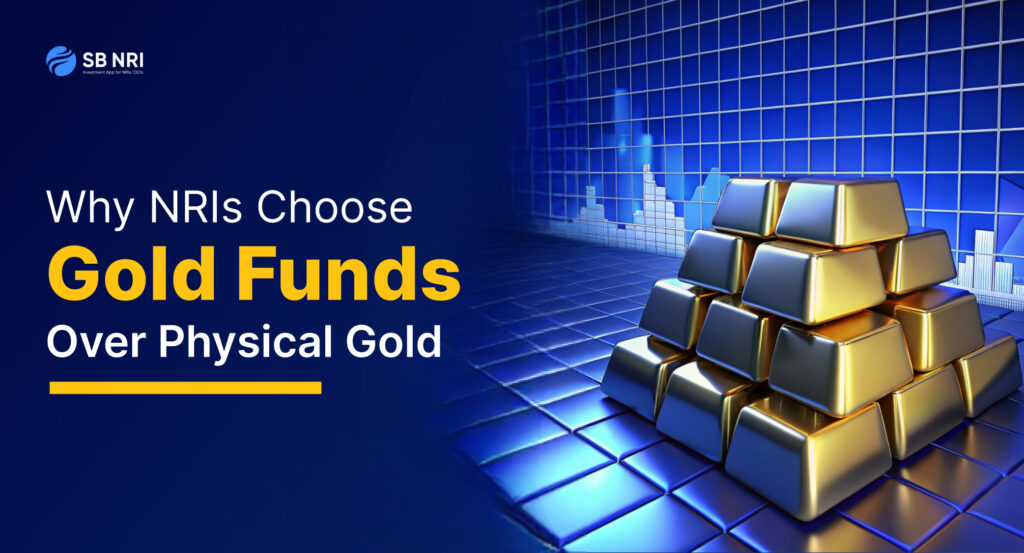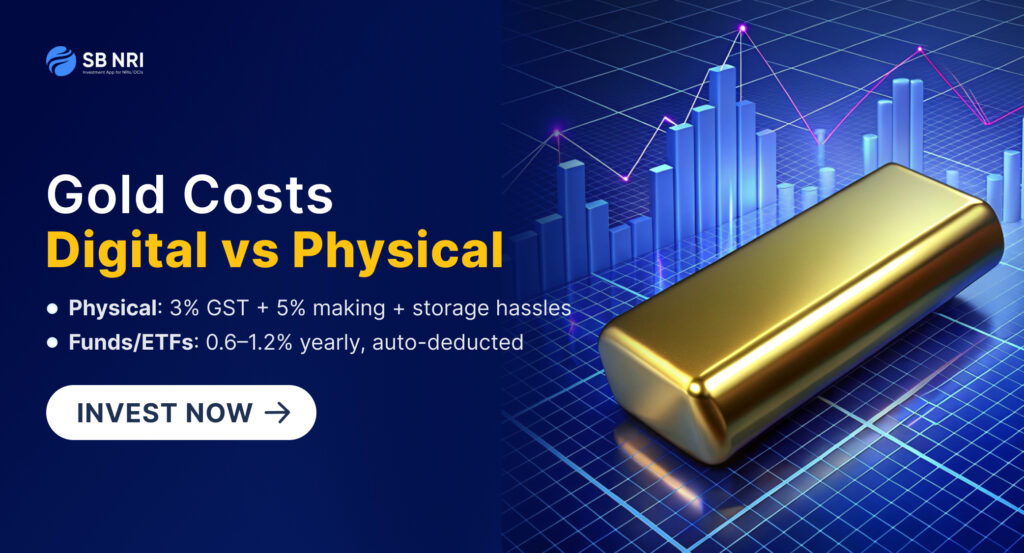
Gold has always symbolized wealth, tradition, and security in Indian culture. According to the World Gold Council, Indian households collectively own approximately 25,000 tones of gold, representing about 11% of the world’s total gold reserves. This gold is predominantly held in the form of jewelry, coins, and bars, often passed down through generations as heirlooms and a symbol of prosperity.
However, for Non-Resident Indians (NRIs), investing in physical gold comes with several challenges. High making charges, GST, secure storage requirements, and limited liquidity make traditional gold investment cumbersome and costly.
In recent years, more NRIs are shifting to Gold Mutual Funds and ETFs to overcome the hassles of physical gold. These digital solutions allow investors to manage gold investments online with ease, transparency, and efficiency, with standardized 99.5% purity, low minimum investments, and the ability to buy or sell instantly.
In this guide, we will explore how NRIs can start investing in Gold Mutual Funds and ETFs to enjoy a smarter, cost-efficient, and hassle-free alternative to physical gold.
The Evolution of Gold Investment
Traditionally, buying gold involved visiting jewellers, checking purity, paying making charges, and arranging secure storage. Each step increases costs, introduces complexity, and carries risk.
In contrast, Gold Mutual Funds and Gold ETFs allow investors to:
- Gain exposure to gold prices without physically handling the metal.
- Invest online from anywhere in the world.
- Track and manage investments digitally, providing transparency, convenience, and security.
For NRIs, this digital approach eliminates many of the hurdles associated with physical gold.
Cost Comparison: Gold Mutual Funds & ETFs vs Physical Gold
Investing in gold involves multiple costs beyond the metal’s market price. For NRIs, understanding these costs is crucial to making an informed choice between digital and physical gold.
1. Expense Ratio vs Making Charges
- Gold Mutual Funds & ETFs: These funds charge a small annual expense ratio, typically between 0.5% and 1%, which covers fund management and operational costs. This fee is automatically deducted from your returns.
- Physical Gold / Jewellery: Jewellery often includes making charges, which are non-refundable when selling, directly reducing the investment’s resale value.
2. GST and Transaction Costs
- Gold Mutual Funds & ETFs: These funds charge an annual expense ratio of 0.5%–1%, with 18% GST applied on the management fee. This brings the effective annual cost to around 0.59%–1.18%, which is automatically deducted from returns.
- Physical Gold: Purchasing jewelry or bars incurs 3% GST on gold value and 5% on making charges, along with potential additional costs for purity verification, hallmarking, and secure storage, making it significantly more expensive and less convenient than digital gold investments.

3. Storage and Insurance
- Gold Mutual Funds & ETFs: Held electronically in secure vaults with insurance included, eliminating the need for personal storage.
- Physical Gold: Requires a secure home safe or bank locker, often with additional insurance costs.
Practical Example
Investing ₹1 lakh in jewelry typically involves making charges of 5%–10%, which amounts to ₹5,000–₹10,000, plus GST at 5% on making charges and 3% on gold value, bringing the total additional cost to around ₹6,500–₹11,000. In contrast, investing the same ₹1 lakh in a Gold ETF avoids these extra charges entirely.
So, you pay only a small annual expense ratio of 0.5%–1%, with 18% GST applied on the management fee, giving direct exposure to gold market prices while keeping costs minimal and transparent.
Key Insight: For NRIs, gold mutual funds and ETFs provide a more cost-efficient, transparent, and hassle-free way to invest compared to physical gold.
Liquidity & Convenience
| Aspect | Gold ETFs | Gold Mutual Funds | Physical Gold |
| Buy/Sell Process | Online through trading platform | Through fund house or online platforms | Visit jeweller or gold buyer |
| Liquidity | High – can be sold instantly | Moderate – redemption usually takes 1–3 business days | Moderate – selling requires assessment and negotiation |
| Ease of Investment | Units as small as 1 gram | SIPs starting from ₹500 | High initial investment, dependent on denomination |
| Management | Passive, tracks gold price | Actively managed by fund managers | Self-managed |
| Ideal For | Active investors, cross-border transactions | Systematic investors, those seeking professional management | Gifting, traditional or ceremonial purposes |
For NRIs who often reside in different countries, the ability to buy, sell, or track gold online provides unmatched convenience.
Plan Your Gold Portfolio Today – Track, invest, and manage your gold holdings anytime, anywhere with the SB NRI App. Don’t let borders limit your wealth growth!
Taxation Insights (FY 2025–26)
Gold ETFs:
- Short-Term Capital Gains (STCG): If held for less than 24 months, gains are taxed at your applicable income tax slab rate.
- Long-Term Capital Gains (LTCG): If held for 24 months or more, gains are taxed at a flat rate of 12.5%. Note that indexation benefits are not available for these gains.
Physical Gold:
- Short-Term Capital Gains (STCG): If held for less than 24 months, gains are taxed at your applicable income tax slab rate.
- Long-Term Capital Gains (LTCG): If held for 24 months or more, gains are taxed at a flat rate of 12.5%. Similar to Gold ETFs, indexation benefits are not available for these gains.
NRIs benefit from simplified taxation when investing in Gold ETFs as compared to physical gold.
Also Read: Best Indian Mutual Funds to Invest in 2025
Gold Investment Options for NRIs: A Side-by-Side Comparison
| Feature / Aspect | Gold ETFs | Gold Mutual Funds | Physical Gold |
| Investment Minimum | 1 unit (1 gram) | SIPs starting ₹500 | Depends on denomination or jewellery design |
| Trading Requirement | Demat account required | No demat account needed | Not required |
| Expense Ratio / Fees | 0.5%–1% annual expense ratio | 1%–2% annual management fee | Making charges + GST, storage, and insurance costs |
| Liquidity | High – traded live on stock exchanges | Moderate – redemption through fund house (1–3 days) | Moderate – selling requires buyer/jeweller and purity check |
| Management Style | Passive – tracks gold price | Active – managed by fund manager | Self-managed |
| Market Exposure | Directly tracks gold prices | Tracks gold and gold-related securities | Physical gold only |
| Storage & Security | Held electronically in secure vaults, insured | Held by fund house, no personal storage needed | Requires secure locker or home safe, insurance optional |
| Ideal For | Active investors, NRIs with demat accounts | Systematic investors seeking professional management | Gifting, traditional or ceremonial purposes |
Invest before gold prices rise – download the SB NRI App now!
Why NRIs Prefer Digital Gold Solutions
- Cross-Border Convenience – No need to ship gold or maintain lockers abroad.
- Cost Efficiency – Avoids making charges, GST, and storage costs.
- Liquidity – Instant buy/sell through online platforms.
- Purity & Transparency – Standardised gold holdings, clearly tracked.
- Diversification & Portfolio Planning – Easy to include in NRI portfolios alongside equities and bonds.
- Secure Investment – Custodial storage with insurance coverage.
Pro Tip: NRIs often balance emotional attachment with financial prudence, making gold mutual funds and ETFs an ideal modern solution.
Conclusion
Although physical gold will always hold sentimental and cultural significance, its practicality as an investment for NRIs has diminished. Gold ETFs and mutual funds offer transparency, liquidity, lower costs, and convenience, making them the preferred choice for modern investors living abroad.
For investors who value emotional connections, physical gold can complement a portfolio; however, for financial efficiency and flexibility, digital gold via ETFs or mutual funds is the smarter choice in 2025.
Frequently Asked Questions (FAQs)
What is the best gold mutual fund for NRIs?
The best gold mutual fund in India depends on your investment goals. Funds like SBI Gold Fund and Fidelity Gold Mutual Fund are popular for reliability and consistent returns.
Can NRIs invest in gold mutual funds vs gold ETFs?
Yes, NRIs can invest in both. Meanwhile, Gold ETFs are ideal for instant liquidity, while gold mutual funds suit systematic investors using SIPs.
How does taxation work for gold mutual funds?
Long-Term Capital Gains are taxed at 12.5% if held for more than 24 months; short-term gains are taxed as per your income slab.
Are gold mutual funds safer than physical gold?
Yes. Moreover, with 99.5% purity, custodial insurance, and no theft risk, gold mutual funds and ETFs offer higher safety and convenience than physical gold.
Why is gold ETF better than physical gold?
Gold ETFs eliminate making charges, GST on purchase, and storage hassles. They offer instant liquidity, 99.5% purity, insurance, and online management, making them cost-efficient and safer than physical gold.
Is it better to invest in physical gold or gold stocks?
Gold stocks expose you to company performance as well as gold prices, which adds risk. For pure gold price exposure, gold ETFs or gold mutual funds are safer and more predictable than gold stocks.
Is it better to invest in physical gold or gold bonds?
Gold bonds (Sovereign Gold Bonds) pay interest and track gold prices but lock-in your investment for a few years. Gold ETFs offer instant liquidity and easier portfolio management, making them more flexible for NRIs.
Why are mutual funds better than gold?
Gold mutual funds provide professional management, systematic investment options (SIPs), no physical handling, secure storage, and transparent pricing—advantages over investing in physical gold.
What has delivered better 10-year returns: Gold ETFs or physical gold?
There’s no universal answer. Returns depend on individual goals, preferences, and circumstances. Gold ETFs track market prices closely and are cost-efficient, but historical returns may vary compared with physical gold depending on purchase and selling timing.
How liquid is a Gold ETF compared with selling gold coins at a jeweller?
Gold ETFs are highly liquid. They can be sold instantly on stock exchanges during trading hours at market price. Physical gold coins require purity checks, haggling, and often lower buyback rates, making them slower and less transparent.
Are Gold ETFs backed by 24-karat physical gold in vaults?
Yes. Most gold ETFs in India are backed by 99.5% pure (24-karat) physical gold, securely held in vaults with a custodian. ETFs are regulated and regularly audited to ensure holdings match the gold in vaults.
Can Gold ETF units be converted into physical gold?
Not usually for small investors. Some ETFs offer physical redemption but require a large quantity. Most retail investors prefer cash redemption due to convenience. Always check the ETF’s policy before investing.
How many gold ETFs is equal to 1 gram of gold?
Most gold ETFs are structured such that 1 unit ≈ 1 gram of gold. Minor variations may occur due to tracking errors and fund expenses. Always check the ETF’s fact sheet for precise details.
What is the disadvantage of gold ETFs?
- No physical delivery for small quantities
- Requires a Demat account
- Management fees (expense ratio)
- Dependent on stock market hours for trading
However, these disadvantages are generally outweighed by convenience, cost efficiency, and security compared with physical gold.
Can we withdraw gold ETFs anytime?
Yes, NRIs can invest in both. On the other hand, Gold ETFs are ideal for instant liquidity, while gold mutual funds suit systematic investors using SIPs.



